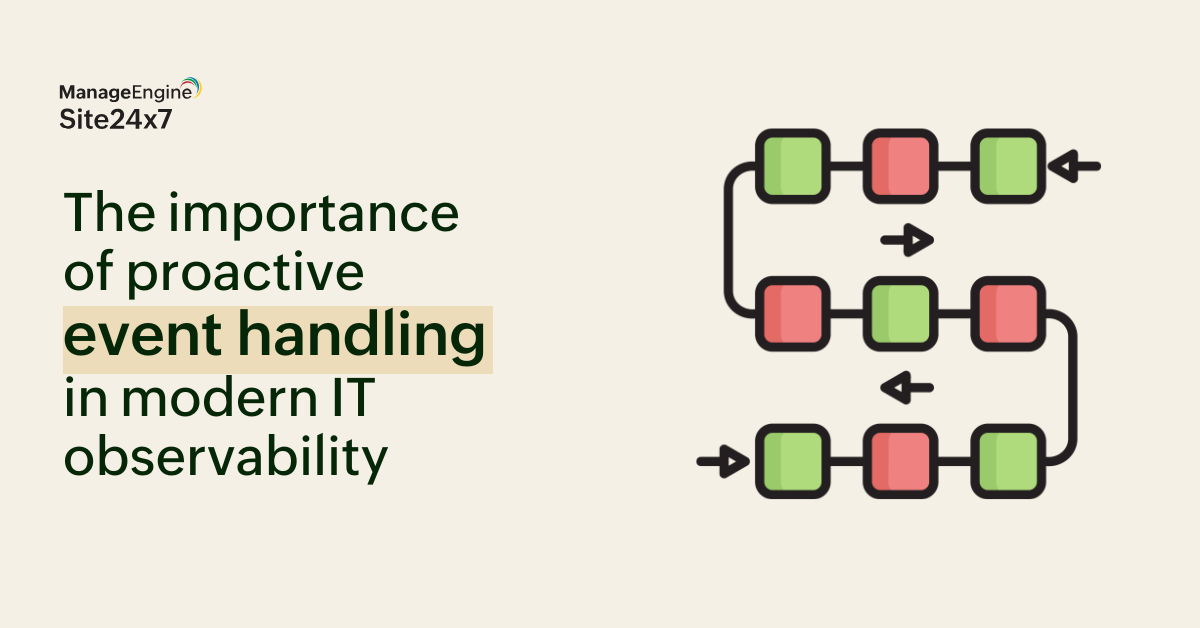The importance of proactive event handling in modern IT observability

What are IT events?
Events are actionable signals derived from observability's core pillars—metrics, traces, and logs—that are converged to deliver end-to-end visibility across your tech stack. They can be used to flag operational shifts or anomalies, such as server crashes, traffic surges, or sluggish database queries. Events from metrics highlight latency, those from traces isolate delays, and those derived from logs (e.g., from Kubernetes) expose crash loops. This helps enable precise monitoring and troubleshooting.
Why events matter in observability
Events transform raw data into foresight. AI-powered, predictive observability can analyze patterns like a MySQL response lag to anticipate disruptions. Such a proactive approach ensures reliability and an optimal UX, supporting broader IT objectives. By illuminating system interdependencies, events streamline efficiency and sharpen decision-making in complex environments.
How events are handled
Event ingestion consolidates data from cloud platforms, applications, and hardware into a centralized hub like Site24x7. AIOps supercharges this process further, unifying high-volume, diverse data in real time; predicting issues; and bridging interoperability gaps. Without such aggregation, insights remain siloed, delaying responses.
Interoperability and events
Interoperability is about making sure different IT systems and tools can work together smoothly, sharing and understanding data without confusion. It happens on two levels: syntactic and semantic. Syntactic interoperability means the systems use a common language or format, like JSON or REST APIs, to exchange data, much like agreeing to speak English in a meeting. Semantic interoperability goes much deeper to ensure the data has the same meaning across systems. For example, if one tool calls a server error a 500 status code and another calls it a critical failure, they need a shared definition to avoid miscommunication.
- Data silos: When tools do not talk to each other, data gets trapped. Imagine one team tracking server health in Splunk and another monitoring app performance in Datadog, with no way to combine the two—key insights stay locked away.
- Noise overload: If every system sends alerts without coordination, you are flooded with notifications. It is like getting 100 emails about minor issues while missing the one about a crashing server.
- Parsing bottlenecks: Hybrid setups (part cloud, part on-site) often use different data formats or protocols. Processing this mix can slow things down, like trying to read a book where every chapter is in a different language.
Despite these challenges, interoperability is worth it. Effective event ingestion gathers and standardizes all this data to help solve core IT problems by creating a unified view. This boosts system performance, letting teams spot and fix issues faster. Observability platforms like Site24x7 shine here, linking events across diverse systems to keep everything running smoothly.
The role of AIOps
AIOps handles event by distilling the volume, latency, and noise from data into a single source of truth. It filters telemetry data (metrics, traces, and logs) for clarity, cutting redundancy. Here are the key advantages:
- Predicts issues with contextual depth
- Automates workflows across integrated tools
- Scales seamlessly, ensuring compliance (e.g., with the GDPR)
Unified observability: How Site24x7 excels
Site24x7 turns event chaos into clarity with:
- Unified ingestion: Aggregates data from AWS, Azure, application performance monitoring, and ITSM (e.g., ManageEngine ServiceDesk Plus) via APIs.
- Intelligent correlation: Machine learning (ML) clusters events, reduces noise, and accelerates root cause analysis.
- Contextual insights: AIOps maps dependencies, forecasts issues, and automates resolutions.
- Seamless interoperability: Integrates with OpenTelemetry for consistent visibility.
This convergence drives actionable outcomes like resolving latency while preserving a seamless UX.
Use cases
- Root cause analysis: Site24x7 links database latency, trace failures, and log errors, slashing mean time to repair (MTTR).
- Outage predictions: The platform detects trends (e.g., traffic spikes) to preempt scaling needs, preventing downtime.
Best practices
- Expand instrumentation: Capture comprehensive telemetry.
- Standardize: Use OpenTelemetry or JSON Schema.
- Filter noise : Apply ML-driven sampling.
- Automate thresholds: Set dynamic alerts.
- Scale smart: Implement data tiering.
- Ensure compliance: Tag events for the GDPR or HIPAA.
Next steps
Modern IT is driven by the cloud and interconnected systems, and it demands unified observability to track significant events across all touchpoints. Beyond event observability, Site24x7 offers enterprise-grade, full-stack, AI-powered monitoring with over 100 integrations (e.g., RUM and OpenTelemetry), AI-driven dashboards, hybrid and multi-cloud support, and task automation. Backed by AIOps, Site24x7 transforms complexity into clarity. Explore Site24x7 today to achieve complete observability.
Topic Participants
Ramkumar Ramaswamy